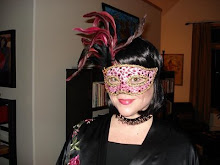“What you see and what you hear
depends a great deal on where you are standing.
It also depends on what sort of person you are.”
~C.S. Lewis, The Magician’s Nephew
I saw him standing
by the big window, his face fixed in concentration and disbelief. “Get
over here, love. You’ve got to see this!”
Certain that he had
spotted one of our four-legged friends, I joined him at the window with that sort
of stealthy gliding motion I have developed after years of quietly
watching, sometimes following, wildlife in this mountain paradise. I scanned the yard, the creek bank, the
massive trees; the space between.
“What is it?” I squinted to sharpen my
view.
“There! You see it?” He pointed with his fingertip on the
glass. “I don’t know…it looks like…a dog?
No, it’s not a dog. What’s it
doing?”
I could see it there by
the water’s edge. “What the heck...is that a…oh my, is that it’s tail? Look at that…it’s standing on its hind legs!”
“It looks...like...a...monkey!
Look at that! Shoot! It's a monkey! Sweetie, get the camera!” He could hardly contain his excitement.
It didn’t make
sense! When have there ever been reports
of monkeys in our mountain community? We
knew this, yet there we were having this random conversation while watching a
couple of monkeys walking around on their hind legs down by the creek in our
back yard.
Just
as we had convinced ourselves that we were witnessing something truly amazing, the monkeys cleared the trees.
Our vision no longer obscured, we realized they weren’t monkeys at
all. They were our neighbors!
Sure they were out of their territory and, true, one need only look at a
diagram illustrating the evolution of man to see the resemblance of humans to
monkeys and understand our mistake, but how could we have thought for even one second that we
had monkeys in our back yard!?! We
laughed so hard I nearly peed in my pants.
That’s the funny
thing about perception: the way we
organize, identify and interpret information to understand and make sense of our
environment! When you get right down to
it, we’re all walking around on our proverbial hind legs seeing monkeys of some
sort. Sometimes our reality coincides
with another’s and we have a shared experience.
Other times, not so much.
Maybe we cannot say
that we are in touch
with reality and he is not, but
should instead say,
His reality is so different from ours
that he can’t
explain his to us,
and we can’t explain ours to him.
~Philip K. Dick
Maybe we’re all
just living in unique worlds, different from each other. No one else has access to the private world
we each carry in our heads, no one else can see or feel what we feel, or
understand what we think we understand, unless we attempt to communicate our
experience to others, which, even then, may not be understood. Yet if reality differs from person to person
(or at least our perception of it), then how can we really claim any singular
form of reality? Might we speak instead
of parallel realities?
Consider a person with multiple personality disorder. His
reality may be quite different from mine, yet as I learn of the disturbing, even nightmarish, events of his life, I know that his experience is as real to him as
my perception of the monkeys in the back yard seemed real to me (however strange and fleeting).
Kind
of makes it hard to say “he’s crazy” or “she’s right” or “they’re wrong” when
you consider that we’re all just doing the best we can to make sense of the
world we live in.
Each of us was once a dream and now we are the dreamers.
In one instance the world is one way.
The next moment, it’s entirely different. The longer I live the more I understand: Most of our experience of the world and the people in it takes place in our minds.








.jpg)



